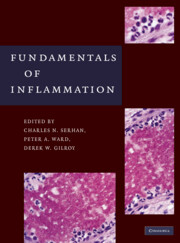Book contents
- Frontmatter
- Contents
- Contributors
- Preface
- PART I THE INFLAMMATORY RESPONSE – AN OVERVIEW
- PART II INDIVIDUAL CELL TYPES
- PART III CHEMICAL MEDIATORS
- PART IV IMMUNOPHARMACOLOGY
- PART V INFLAMMATORY DISEASES/HISTOLOGY
- PART VI ANIMAL MODELS OF INFLAMMATION
- 27 Models of Acute Inflammation – Air-Pouch, Peritonitis, and Ischemia-Reperfusion
- 28A Experimental Models of Glomerulonephritis
- 28B Glomerulonephritis and Ischemia Reperfusion Injury
- 29 Asthma
- 30 Animal Models of Rheumatoid Arthritis
- 31 Ocular Inflammation Models
- 32 Atherosclerosis in Experimental Animal Models
- 33 Oral Inflammation and Periodontitis
- 34 Pathogens and Inflammation
- Index
- References
29 - Asthma
from PART VI - ANIMAL MODELS OF INFLAMMATION
Published online by Cambridge University Press: 05 April 2014
- Frontmatter
- Contents
- Contributors
- Preface
- PART I THE INFLAMMATORY RESPONSE – AN OVERVIEW
- PART II INDIVIDUAL CELL TYPES
- PART III CHEMICAL MEDIATORS
- PART IV IMMUNOPHARMACOLOGY
- PART V INFLAMMATORY DISEASES/HISTOLOGY
- PART VI ANIMAL MODELS OF INFLAMMATION
- 27 Models of Acute Inflammation – Air-Pouch, Peritonitis, and Ischemia-Reperfusion
- 28A Experimental Models of Glomerulonephritis
- 28B Glomerulonephritis and Ischemia Reperfusion Injury
- 29 Asthma
- 30 Animal Models of Rheumatoid Arthritis
- 31 Ocular Inflammation Models
- 32 Atherosclerosis in Experimental Animal Models
- 33 Oral Inflammation and Periodontitis
- 34 Pathogens and Inflammation
- Index
- References
Summary
INTRODUCTION
Asthma is a disease of chronic airway inflammation. This condition is prevalent worldwide and accounts for significant morbidity, excess mortality, and substantial health care expenditures [1, 2]. Asthma is clinically defined by three characteristics, namely reversible airflow obstruction, airway hyperresponsiveness, and airway inflammation [1]. There is no cure for asthma, but many therapies have been developed to lessen the burden of the disease. In light of the need for additional therapeutics to treat and ultimately cure asthma, several animal experimental models have been developed to perform preclinical investigation of asthma pathogenesis and novel therapeutics. Simply stated, asthma is only a human disease. None of the current animal models entirely recapitulates asthma [3], but they have proven very useful in the investigation of asthma traits. In this chapter, the most common animal models of asthma and their features will be described with particular attention to the airway inflammatory responses.
ASTHMA PATHOBIOLOGY
Asthma has a complex pathogenesis and can be considered a clinical syndrome of intermittent dyspnea, wheezing, chest tightness, and/or cough. In most subjects, airway inflammation is present [1]. The inflammatory cell infiltrate is enriched with eosinophils, T lymphocytes and, in some cases, neutrophils, especially in the setting of asthma exacerbations. This complex, chronic airway inflammation is likely initiated and driven by signals from sentinel cells in the airway, including airway epithelia and dendritic cells, responding to provocative stimuli.
- Type
- Chapter
- Information
- Fundamentals of Inflammation , pp. 376 - 384Publisher: Cambridge University PressPrint publication year: 2010



